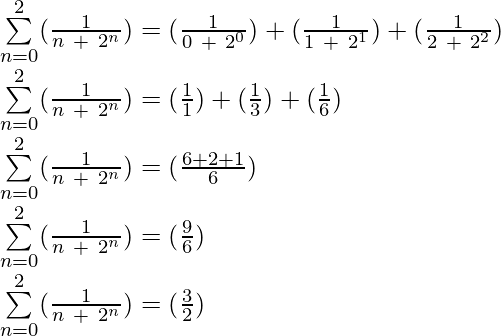在数学中,序列是数字的集合或列表,它们之间具有逻辑/顺序或模式。例如,1、5、9、13,…是在每个连续的下一个项之间相差4的序列,并且每个项可以以1 + 4 *(n – 1)的形式表示,其中n是该项的第n个项顺序。该序列可分为3类:
- 算术序列
- 几何序列
- 调和序列
算术序列
每个连续项具有相同差且该差可以为正,负甚至为零的序列称为算术序列。
例子:
1) 0, 2, 4, 6, … in this sequence each and every consecutive term has a difference of 2 between them and nth term of sequence can be represented as 2 * ( n – 1 ).
2) 0, 5, 10, 15, … is another example of arithmetic sequence with a difference of 5 between each consecutive number and nth term of sequence can be represented as 5 * ( n – 1 ).
几何序列
每个连续项具有相同比率的序列称为几何序列。
例子:
1) 1, 5, 25, 125 … in this sequence, each consecutive term have a ratio of 5 with the term before it and nth term of sequence can be represented as 5 ( n – 1 ).
2) 1, -2, 4, -8, 16, … in this sequence each consecutive term have a ratio of -2 with the term before it and nth term of sequence can be represented as ( -2 )( n – 1 ).
调和序列
每个项的倒数形成算术序列的序列称为谐波序列。
例子:
(1/5), (1/10), (1/15), (1/20),… in this sequence the reciprocal of each term that is 5, 10, 15, 20, … forms an arithmetic sequence with a difference of 5 between each consecutive term.
什么是求和符号?
求和表示法是一种简单的查找序列之和的方法。求和表示法也称为sigma表示法。西格玛(Sigma)是指希腊字母西格玛(Σ)。序列的极限如图1所示,其中下限是序列的开始索引,上限是序列的结束索引。如图1所示,下限为1,上限为4,因此这意味着我们需要第一,第二,第三和第四项的总和,即(2 * 1)+(2 * 2)+(2 * 3)+(2 * 4)= 2 + 4 + 6 + 8 = 20。
汇总符号:

算术序列的求和符号
算术序列的和表示形式为Σ(a + b * n),其中a是序列的第一项,b是序列的任何两个连续项之间的公共差,因此该序列的第n个项将是形式(a +(b * n))。
例子:
Let the arithmetic sequence be 0, 2, 4, 6, … so for making the summation notation we need to find the values of ‘a’ and ‘b’ where ‘a’ is the first term which is 0 so a = 0 and b is the common difference between any 2 consecutive terms which is 2 in this case, so b = 2.Therefore summation notion of sequence would be Σ (0 + (2 * n)) where the lower limit is 0 and the upper limit is ∞ as the first term of the sequence is given as 0 and ending is not defined.
算术求和符号:

几何序列的求和符号
几何序列的和表示形式为Σ(a * b n ),其中a是序列的第一项,b是序列的任何两个连续项之间的公比,因此该序列的第n个项将是形式(a * b n )。
例子:
Let the geometric sequence be 2, 10, 50, 250, … so for making the summation notation we need to find the values of ‘a’ and ‘b’ where ‘a’ is the first term which is 2 so a = 2 and b is the common ratio between any 2 consecutive terms which is 5 in this case, so b = 5.Therefore summation notion of sequence would be Σ (2 * 5 n) where the lower limit is 0 and the upper limit is ∞ as the first term of the sequence is given as 0 and ending is not defined.
几何求和符号:

调和序列的加法表示法
调和序列的和表示形式为Σ(1 /(a + b * n)),其中a是序列的第一项的倒数,b是序列的任何两个连续项的倒数之间的公共差,因此,序列的第n个项的形式为(1 /(a + b * n))。
例子:
Let the arithmetic sequence be 1/2, 1/4, 1/6, … so for making the summation notation we need to find the values of ‘a’ and ‘b’ where ‘a’ is the reciprocal first term which is 2 so a = 2 and b is the common difference between the reciprocal of any 2 consecutive terms which is 2 in this case, so b = 2.Therefore summation notion of sequence would be Σ (1/( 0 + 2 * n)) where the lower limit is 1 and the upper limit is ∞ as the first term of the sequence is given as 1/2 and ending is not defined.
谐波求和符号:

例子
示例1:找到序列的前4个项:a n = 2 * x n + 1且n> 0?
解决方案:
As we should take care to replace n ( and not x ) with the first 4 natural numbers as n is not equal to 0.
a1 = 2 * x1 + 1
a2 = 2 * x2 + 1
a3 = 2 * x3 + 1
a4 = 2 * x4 + 1
示例2:找到序列的前6个项:a n = ![]() 并且n≥0?
并且n≥0?
解决方案:
We have to replace n by the first 6 while numbers (0, 1, 2, 3, 4, 5).
a0 = ![]()
a1 = ![]()
a2 = ![]()
a3 = ![]()
a4 = ![]()
a5 = ![]()
示例3:评估 对于k = 2和k = 4?
对于k = 2和k = 4?
解决方案:
For k = 2
 = (2 * 1) + (2 * 2) = 2 + 4 = 6
= (2 * 1) + (2 * 2) = 2 + 4 = 6
For k = 4
 = (2 * 1) + (2 * 2) + (2 * 3) + (2 * 4) = 2 + 4 + 6 + 8 = 20
= (2 * 1) + (2 * 2) + (2 * 3) + (2 * 4) = 2 + 4 + 6 + 8 = 20
示例4:评估 ?
?
解决方案:
 = (51) + (52) + (53) + (54) = 5 + 25 + 125 + 625 = 780
= (51) + (52) + (53) + (54) = 5 + 25 + 125 + 625 = 780
示例5:评估 ?
?
解决方案:
示例6:以扩展形式编写:  最多4个学期?
最多4个学期?
解决方案:

